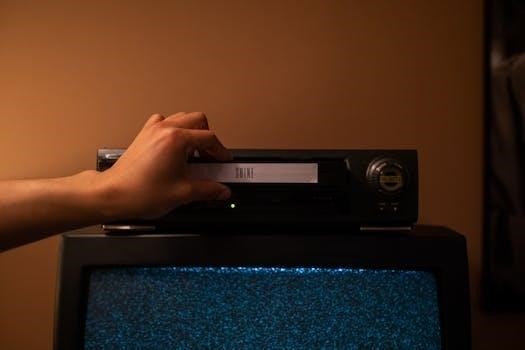Hakko FR-300 Desoldering Tool Manual⁚ An Overview
The Hakko FR-300 desoldering tool manual provides essential information for safe and effective operation. It covers key aspects such as safety precautions‚ operating instructions‚ maintenance‚ and troubleshooting. Users should consult the manual before using the FR-300 to ensure proper usage and longevity.
The Hakko FR-300 is a specialized electrical tool designed for the precise task of desoldering components from printed circuit boards. Its primary function involves melting and extracting solder‚ allowing for the safe removal of electronic components without damaging the board or the components themselves. This tool is intended for use by trained technicians and hobbyists familiar with electronic repair and assembly techniques.
The FR-300 is not designed for general soldering purposes or any applications outside of desoldering electronic components. Using the tool for unintended purposes can lead to damage or injury. Always adhere to the safety guidelines outlined in the manual and ensure a proper understanding of its operation before use. The manual serves as a comprehensive guide‚ detailing the tool’s features‚ maintenance‚ and troubleshooting steps‚ thereby maximizing its lifespan and ensuring safe operation.
Proper handling and maintenance‚ as detailed in the manual‚ are crucial for the optimal performance and extended lifespan of the Hakko FR-300. Regular cleaning and inspection will prevent clogs and ensure efficient solder removal.
Key Features of the FR-300
The Hakko FR-300 desoldering tool boasts several key features that make it a valuable asset for electronics work. One notable feature is its rapid heating capability‚ allowing for quick and efficient solder melting. The tool also incorporates a powerful vacuum pump‚ ensuring effective solder extraction from circuit boards. Its adjustable temperature settings provide versatility for working with various types of solder and components.
The FR-300 is designed with user comfort in mind‚ featuring an ergonomic handle for extended use without fatigue. The tool also includes easily replaceable nozzles‚ accommodating different component sizes and board layouts. Additionally‚ the FR-300 incorporates a self-cleaning mechanism‚ simplifying maintenance and prolonging the tool’s lifespan. Furthermore‚ the FR-300’s antistatic design protects sensitive electronic components from damage during the desoldering process.
The Hakko FR-300 provides technicians with a reliable and precise instrument for desoldering tasks‚ enhancing productivity and minimizing the risk of damage to valuable components.
Safety Precautions and Warnings
When operating the Hakko FR-300 desoldering tool‚ it is imperative to adhere to strict safety precautions to prevent injury and equipment damage. Always wear appropriate eye protection‚ such as safety glasses or goggles‚ to shield your eyes from molten solder and debris. Ensure adequate ventilation in the work area to avoid inhaling harmful fumes produced during the desoldering process.
The FR-300 operates at high temperatures‚ so avoid touching the nozzle or heating element to prevent burns. Before performing any maintenance or cleaning‚ disconnect the tool from the power source and allow it to cool completely. Never use the FR-300 near flammable materials or in wet environments. Inspect the power cord regularly for damage and replace it if necessary.
Keep the tool out of reach of children and unauthorized personnel. Do not attempt to modify or disassemble the FR-300‚ as this could compromise its safety features and void the warranty. By following these safety guidelines‚ you can ensure a safe and productive desoldering experience.

Operating Instructions for the FR-300
To operate the Hakko FR-300‚ begin by plugging it into a grounded outlet. Set the desired temperature and allow the tool to heat up. Position the nozzle over the solder joint‚ melt the solder‚ and activate the vacuum to remove it.
Powering On and Setting Temperature
Before initiating any desoldering tasks with the Hakko FR-300‚ it’s crucial to ensure the tool is correctly powered on and the temperature is accurately set. Begin by connecting the FR-300 to a grounded electrical outlet‚ verifying the power source matches the tool’s specified voltage requirements to prevent damage.
Once connected‚ turn on the power switch‚ typically located on the unit’s body. The FR-300 features adjustable temperature settings to accommodate various solder types and component sensitivities. Consult the manual to determine the optimal temperature for your specific desoldering needs. Use the temperature control dial or buttons to adjust the temperature accordingly.
Allow sufficient time for the tool to reach the set temperature; a ready indicator light will usually illuminate when the desired temperature is achieved. Regularly calibrate the temperature for accuracy‚ ensuring efficient and safe desoldering operations. This precise control minimizes the risk of damaging sensitive electronic components during the desoldering process.
Desoldering Process
Once the Hakko FR-300 has reached the set temperature‚ the desoldering process can begin. Position the FR-300’s nozzle directly over the solder joint you wish to remove. Ensure the nozzle makes full contact with the solder‚ allowing for efficient heat transfer. Activate the vacuum pump by pressing the trigger or button‚ depending on the model.
The vacuum will suction the molten solder away from the joint and into the collection chamber of the FR-300. Maintain steady pressure and positioning until all the solder is removed. For stubborn joints‚ gently rock the nozzle to aid in melting and extraction. Be cautious not to overheat components‚ which can cause damage.
After removing the solder‚ release the vacuum and carefully lift the FR-300 away from the board. Inspect the joint to ensure all solder has been removed. If necessary‚ repeat the process. Regularly empty the solder collection chamber to maintain optimal performance and prevent clogging. Always follow safety guidelines to avoid burns.

Maintenance and Cleaning
Proper maintenance and cleaning are crucial for extending the lifespan and maintaining the performance of your Hakko FR-300 desoldering tool. Regularly clean the nozzle to remove any accumulated solder residue‚ preventing clogs and ensuring efficient heat transfer. Use a cleaning drill or a specialized nozzle cleaning tool to carefully remove obstructions.
The solder collection chamber should be emptied frequently to prevent overflow and potential damage to the tool. After emptying‚ inspect the chamber for any remaining solder particles and clean as needed. Periodically check the filter for clogs or damage‚ replacing it when necessary to maintain optimal vacuum performance.
Ensure the heating element is free from debris and inspect the power cord for any signs of wear or damage. Store the FR-300 in a clean‚ dry environment when not in use. Following these maintenance practices will contribute to the longevity and reliable operation of your desoldering tool‚ saving you time and money in the long run.

Troubleshooting Common Issues
Encountering issues with your Hakko FR-300 desoldering tool? Let’s troubleshoot common problems. If the tool isn’t heating‚ first verify the power cord is securely connected and the power switch is on. Check the fuse and replace if necessary. If the tool heats but doesn’t desolder effectively‚ ensure the nozzle is clean and free of obstructions.
A weak vacuum can also hinder desoldering. Confirm the solder collection chamber is empty and the filter isn’t clogged. Inspect the vacuum hose for leaks or damage. If the tool is sputtering solder‚ the temperature may be too low or the solder may be contaminated. Adjust the temperature accordingly and use clean solder.
If the FR-300 shuts off unexpectedly‚ it may be overheating. Allow it to cool down before resuming use. Persistent problems may indicate internal damage‚ requiring professional repair. Remember to always consult the manual for specific troubleshooting steps and safety precautions before attempting any repairs.
FR300 vs FR301
The Hakko FR-300 and FR-301 are both desoldering tools‚ but the FR-301 is the successor to the FR-300. One key difference lies in their heating performance; the FR-301 boasts a faster heat-up time‚ allowing for quicker operation. The FR-301 also features an improved heating element and control system‚ providing more stable and precise temperature control during desoldering tasks.
Another notable enhancement is the FR-301’s nozzle design‚ which facilitates easier solder removal and reduces the risk of clogging. Furthermore‚ the FR-301 incorporates a more ergonomic handle for improved comfort during prolonged use. While the FR-300 is still a capable desoldering tool‚ the FR-301 offers enhanced performance‚ precision‚ and user comfort‚ making it a worthwhile upgrade for professionals and hobbyists alike. The FR-300 is discontinued.

Eton FR300 Emergency Radio Manual
The Eton FR300 emergency radio manual provides instructions for operating the device‚ including its power sources‚ radio functions‚ and emergency features. It details battery operation and how to use the hand crank for power.
Power Sources and Battery Operation
The Eton FR300 emergency radio offers multiple power sources for versatile use. It can be powered by its built-in rechargeable Ni-MH battery pack‚ which can be charged via a dynamo crank or an AC adapter (not included). Cranking the dynamo rapidly‚ about two turns per second‚ can provide up to 60 minutes of low-volume listening. The AC adapter acts as a charger when plugged into the DC 4.5 V socket‚ requiring about 8 hours for a full charge.
Alternatively‚ the FR300 can operate on three AA batteries (not included). Alkaline or lithium AA batteries are recommended for the best overall performance. Rechargeable AA batteries can also be used but must be charged separately in an external charger. When using the built-in rechargeable battery‚ ensure it is fully charged for optimal use during emergencies or when other power sources are unavailable. The flexibility in power options ensures the FR300 remains functional in various situations.
Using the Radio and Other Features
The Eton FR300 emergency radio provides several features beyond basic radio functionality. It includes AM‚ FM‚ NOAA Weather Band‚ and VHF-TV reception‚ allowing users to stay informed about news and weather updates. To use the radio‚ simply select the desired band using the band selector switch and adjust the volume to a comfortable level. The FR300 also features a built-in flashlight‚ providing a convenient light source during emergencies or power outages.
Additionally‚ the radio includes a cell phone charger‚ enabling users to charge their mobile devices in situations where traditional power sources are unavailable. To charge a cell phone‚ connect it to the radio using a compatible USB cable and utilize the dynamo crank to generate power. The FR300’s all-in-one design makes it a valuable tool for emergency preparedness‚ offering multiple functions in a compact and self-powered device. Proper understanding of these features ensures users can maximize the radio’s utility during critical situations.
